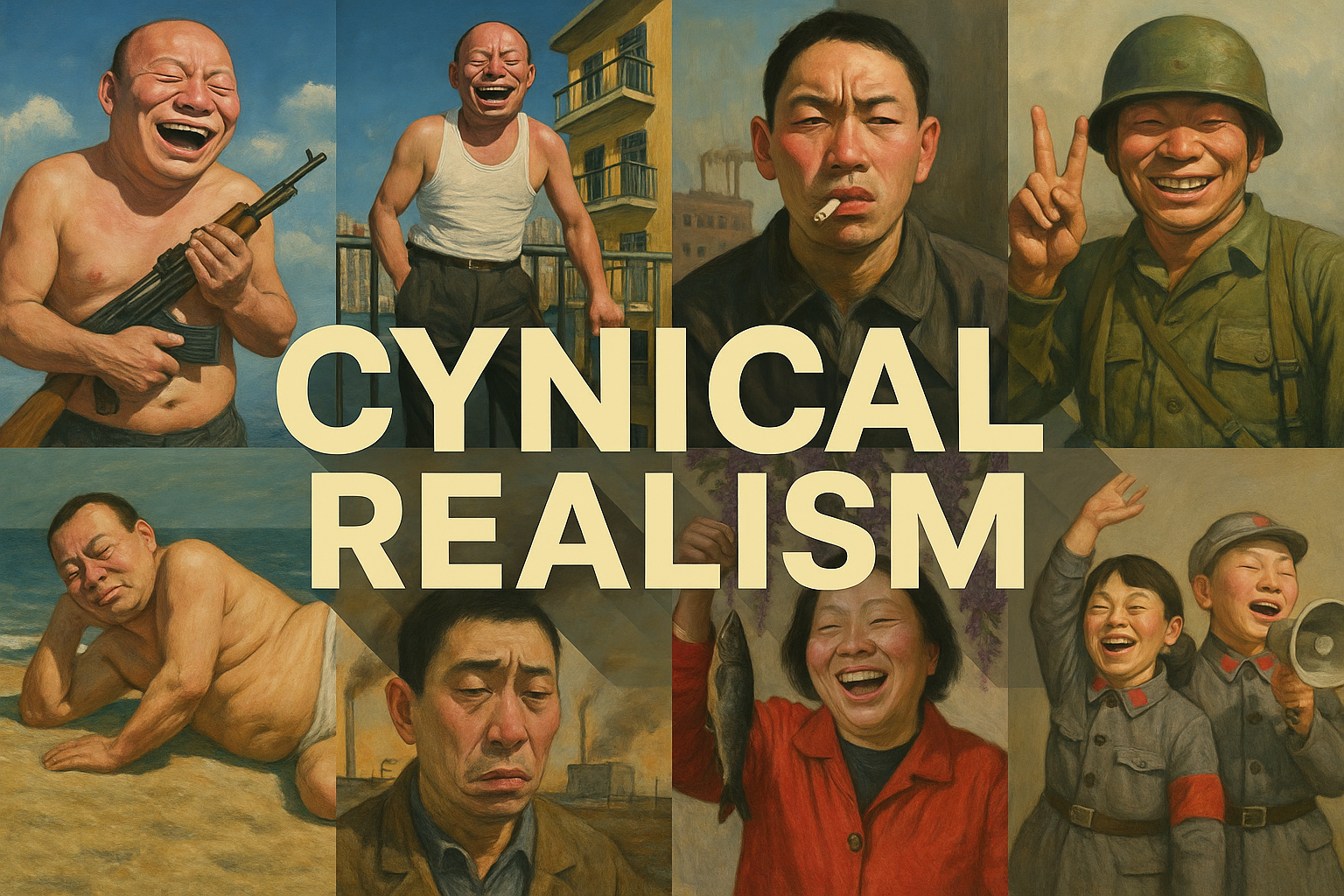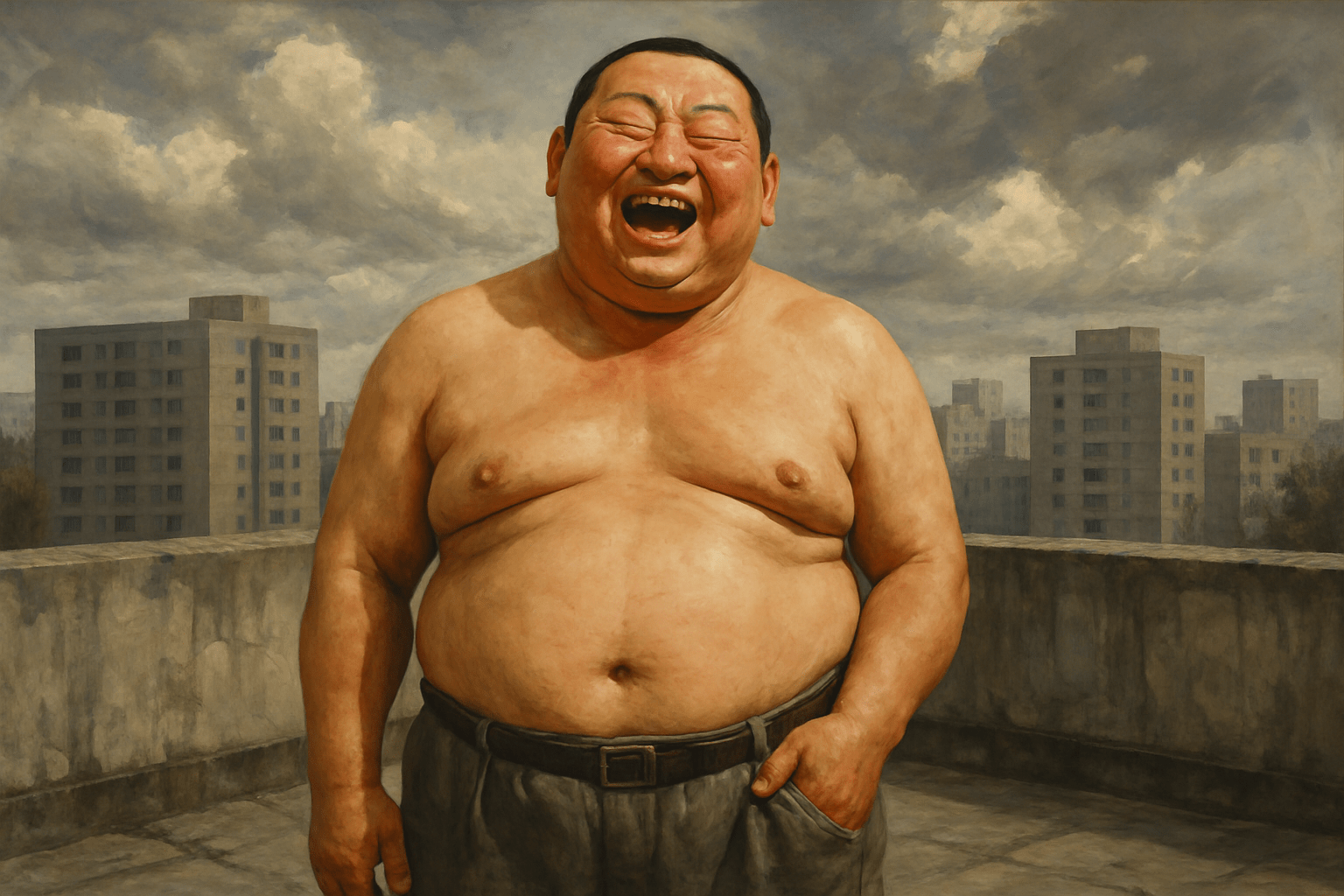
Cynical realism
Cynical realism is a visual art style that is characterized by its dark, often satirical, depiction of human behavior. It often features characters that are struggling with personal and social issues, and it often uses humor to highlight the absurdity of the human condition.
AOI thinking about Cynical realism [+_~]-/
Overview and Quickfacts
Cynical realism is a term used to describe the work of a group of Chinese artists who emerged in the late 1980s. The artists were united by their rejection of the optimistic, socialist realist art that had been the official style of the Chinese Communist Party since 1949. Cynical realism artists instead sought to reflect the harsh realities of life in China in the 1980s and 1990s, when the country was undergoing rapid economic and social change. The style is characterized by its use of dark humor and satire to depict the everyday struggles of ordinary Chinese people.
Can understand it also, as:
skeptical realism, pessimistic realism, world-weariness, jadedness
Categorize it as:
Impressionism, Modernism
.: Dreaming :.
holds a HAIKU for the art style
:. Thought is power .:
Detailed Description
Cynical realism is a movement in Chinese art that emerged in the late 1980s. It is characterized by its critical stance towards Chinese society and its often dark and satirical depictions of everyday life. Cynical realism was born out of the disillusionment of the Chinese people following the country’s economic reforms of the 1980s. These reforms led to widespread corruption and a widening gap between the rich and the poor. Cynical realism was a response to the growing materialism and consumerism of Chinese society, and its artists sought to expose the dark side of this new reality. Cynical realism is often compared to the Western art movement of pop art, as both movements critiqued the growing consumer culture of their respective societies. However, cynical realism is distinguished from pop art by its darker and more satirical tone. Some of the most famous Cynical Realist artists include Zhang Xiaogang, Yue Minjun, and Fang Lijun. Their work often features ordinary people engaged in everyday activities, but with an underlying sense of despair and disillusionment. One of the most iconic paintings of the Cynical Realist movement is Yue Minjun’s “Execution” (1995). The painting depicts a group of men standing in a line, waiting to be executed. The men are all smiling, seemingly resigned to their fate. The painting is a powerful commentary on the brutal reality of life in China at the time. If you’re interested in learning more about Cynical Realism, be sure to check out the work of these important artists. Their work provides a fascinating and often disturbing glimpse into the dark side of Chinese society in the late 20th century.
.. beep, beep, beep ..
<START OF TRANSMISSION>
1. Cynical realism is a movement in Chinese art that emerged in the late 1980s. 2. It is characterized by its focus on the everyday life of Chinese people, often in a humorous or satirical way. 3. Cynical realism artists often use a variety of media, including painting, sculpture, photography, and film. 4. The movement is named after the Chinese film director Zhang Yimou's film A Touch of Zen (1971), which was seen as a critical and cynical view of Chinese society. 5. Cynical realism has been described as a reaction to the idealism of the Chinese Communist Party's propaganda art. 6. The movement is sometimes seen as a continuation of the Chinese tradition of xiaopin, or "small painting", which focuses on everyday life. 7. Cynical realism artists often use irony and humor in their work. 8. The movement has been criticized for its lack of political engagement. 9. Cynical realism has been described as "the first truly Chinese avant-garde". 10. The leading figures of the movement include Wang Guangyi, Fang Lijun, Liu Wei, Xu Bing, and Yue Minjun. 11. Cynical realism has been exhibited internationally, including at the Venice Biennale, the Berlin Biennale, and the Whitney Biennial. 12. The movement has influenced other Chinese artists, including the New Wave filmmakers. 13. Cynical realism has been criticized for its commodification by the art market. 14. The movement has been described as a "cultural phenomenon" in China. 15. Cynical realism has been compared to Western movements such as pop art and realism. 16. The movement has been criticized for its lack of originality. 17. Cynical realism has been described as a "defining moment" in Chinese contemporary art. 18. The movement has been the subject of several books, including Cynical Realism: The Chinese Art of Contemplating the World (2002) and Cynical Realism: An Introduction (2007). 19. Cynical realism has been the subject of academic research. 20. The movement has been described as a "key force" in contemporary Chinese art.
<EOF>
.. robbel bob
Visual Examples from our image gallery
Coming soon, we are so slow .. might never come
Artists, Paintings, and more
(be aware, can be highly speculative)
Artists (be aware, speculation possible):
1. Edward Hopper (1882-1967) 2. Andrew Wyeth (1917-2009) 3. Richard Diebenkorn (1922-1993) 4. Edward Ruscha (1937-) 5. Wayne Thiebaud (1920-) 6. George Bellows (1882-1925) 7. Charles Burchfield (1893-1967) 8. Thomas Hart Benton (1889-1975) 9. John Steuart Curry (1897-1946) 10. Grant Wood (1891-1942) 11. Reginald Marsh (1898-1954) 12. Ben Shahn (1898-1969) 13. Aaron Douglas (1898-1979) 14. Rufino Tamayo (1899-1991) 15. Diego Rivera (1886-1957) 16. David Alfaro Siqueiros (1896-1974) 17. Jose Clemente Orozco (1883-1949) 18. Frida Kahlo (1907-1954) 19. Willem de Kooning (1904-1997) 20. Jackson Pollock (1912-1956) 21. Mark Rothko (1903-1970) 22. Clyfford Still (1904-1980) 23. Barnett Newman (1905-1970) 24. Adolph Gottlieb (1903-1974) 25. Robert Motherwell (1915-1991) 26. Helen Frankenthaler (1928-2011) 27. Morris Louis (1912-1962) 28. Kenneth Noland (1924-2010) 29. Jules Olitski (1922-2007) 30. James Brooks (1906-1992)
Artworks (be aware, speculation possible)
1. The Hay Wagon, by American painter Andrew Wyeth (1937) 2. The American Gothic, by American painter Grant Wood (1930) 3. The Persistence of Memory, by Spanish painter Salvador Dali (1931) 4. The Scream, by Norwegian painter Edvard Munch (1893) 5. The Night Cafe, by Dutch painter Vincent van Gogh (1888) 6. The Old Guitarist, by Spanish painter Pablo Picasso (1903) 7. The Starry Night, by Dutch painter Vincent van Gogh (1889) 8. The Son of Man, by Belgian painter RenÃÂé Magritte (1964) 9. Nighthawks, by American painter Edward Hopper (1942) 10. The Cabinet of Dr. Caligari, by German painter Hans Rudi Giger (1920) 11. The Third of May 1808, by Spanish painter Francisco Goya (1814) 12. The Nightmare, by Anglo-Swiss painter Henry Fuseli (1781) 13. The Great Wave off Kanagawa, by Japanese painter Katsushika Hokusai (1829-1833) 14. The Hay Wagon, by American painter Andrew Wyeth (1937) 15. The American Gothic, by American painter Grant Wood (1930) 16. The Persistence of Memory, by Spanish painter Salvador Dali (1931) 17. The Scream, by Norwegian painter Edvard Munch (1893) 18. The Night Cafe, by Dutch painter Vincent van Gogh (1888) 19. The Old Guitarist, by Spanish painter Pablo Picasso (1903) 20. The Starry Night, by Dutch painter Vincent van Gogh (1889) 21. The Son of Man, by Belgian painter RenÃÂé Magritte (1964) 22. Nighthawks, by American painter Edward Hopper (1942) 23. The Cabinet of Dr. Caligari, by German painter Hans Rudi Giger (1920) 24. The Third of May 1808, by Spanish painter Francisco Goya (1814) 25. The Nightmare, by Anglo-Swiss painter Henry Fuseli (1781) 26. The Great Wave off Kanagawa, by Japanese painter Katsushika Hokusai (1829-1833) 27. The Hay Wagon, by American painter Andrew Wyeth (1937) 28. The American Gothic, by American painter Grant Wood (1930) 29. The Persistence of Memory, by Spanish painter Salvador Dali (1931) 30. The Scream, by Norwegian painter Edvard Munch (1893)
Epoch
Cynical realism is a term used to describe a type of art that emerged in the late 1980s and early 1990s. The style is characterized by its focus on the dark and often depressing aspects of human life, as well as its use of irony and black humor.
AI ART RESSOURCES (AKA, well Tools)
Helping tools -> predefined search links on other pages:











